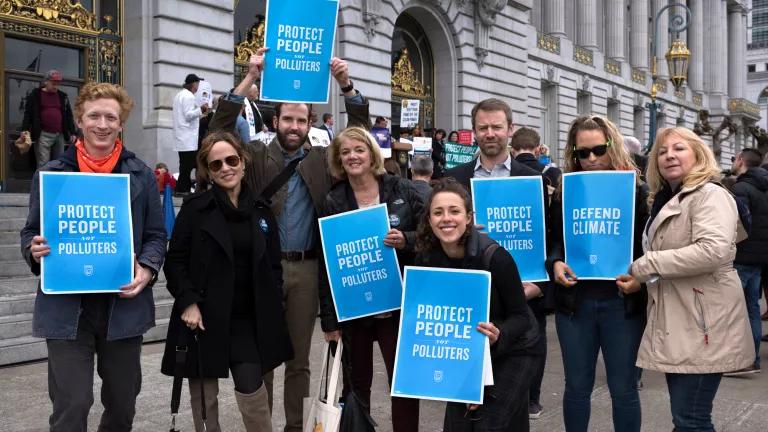Much has been written about the constructive role that corporations played in the COP 21 climate negotiations in Paris last month; many companies had strenuously opposed previous efforts to negotiate a treaty, but this round, the private sector was much more supportive. Many companies even came to the COP with meaningful and specific commitments for reducing their own carbon footprint.
Bravo! And not just because it reduced tension during the negotiation itself, by signaling that a good economy and good environment can go hand in hand. Also, multinational corporations can play a key role internationally in achieving reductions. Unlike governments whose authority is limited outside their own borders, multinational corporations can leverage reductions across dozens of countries, both industrialized and less developed, one swoop -- with their sourcing decisions. What the buyer wants, the buyer gets, we hear over and over again from factories in China. Now some buyers will want carbon reductions along with their goods! So, allons! (let's get going), as the French would say!
Key to maximizing the potential in corporate reductions is for companies to focus where their biggest impacts lie - in their supply chain. Until now, far too many companies have focused only on carbon emissions from their corporate offices and retail spaces (known as Scope 1 and Scope 2 reductions), because that was an easy place to start. Enough "getting your own house in order", I say, the planet needs bigger bang for the buck! Supply chains are where an estimated 75-80% of a manufacturing company's carbon emissions lie, and there is little sense in focusing corporate efforts on the smallest slice of its emissions pie.
Furthermore, so much low-hanging fruit remains to be picked for suppliers abroad, where inefficient production processes can be upgraded with business-friendly, cost-savings efficiency improvements. NRDC's Clean by Design program, for example, which targets textile dyeing and finishing in the apparel industry in China, has found juicy opportunities to reduce energy use at every single plant in the program. On average, mills reduced energy use by 6.5% and are now saving $440,000 annually, with projects that generally paid for themselves in less than a year. Those are business-friendly carbon reductions if I've ever seen them.
Happily, supply chain impacts did receive unprecedented attention by key advocacy groups in Paris. The Carbon Disclosure Project (CDP) launched a major supply chain initiative for the meeting, highlighting the glaring need for this change in corporate focus. Noting that only one-quarter of its 4,000 reporting companies had even begun to engage with supplier emissions at all, CDP successfully recruited 75 companies into a supply chain initiative and it projects that these actions will reduce a total of 60 million tons of carbon by 2020.
In parallel, We Mean Business, a coalition of over 500 businesses and investors created to raise corporate ambitions around target setting and to drive bolder climate action, offered seven types of commitment areas to members to direct activity, including supply chain reductions. Those companies whose supply chain emissions covered a significant portion of their overall emissions were encouraged to target their reductions there, along with disclosing GHG emissions inventories on an annual basis. Fingers crossed that those companies with vast percentages of their carbon footprint in their supply chain focus their effort in that area - I'll be checking.
Working off a separate piece of music here in the U.S., the Obama Adminitration successfully recruited more than 150 corporate commitments on climate for Paris, creating a coalition of the willing, so to speak, which were invited to commit to whatever specifics they could. Disappointingly, most companies missed the mark on supply chain commitments. Some, such as Apple, which we know DOES do excellent supply chain work in China, nonetheless failed to make a commitment in that area; its commitments were for renewable energy for its corporate facilities, data centers, and retail stores only. What is that about, Apple?? And hey, HP: you committed to supply chain, but only to your Tier One suppliers, which do final assembly. Your carbon emissions don't come from those factories, they are in the material suppliers making the printed circuit boards, enclosures, glass, etc. Get your eye on the ball, please!
There are notable examples of supply chain leadership from other companies, however, including Coca Cola and General Mills, which committed to reductions from "farm to fork". We got some good palm oil and deforestation commitments from companies like Hersheys, McDonalds, and Cargill, which we would have expected, thank you for that. Target, a strong participant in NRDC's Clean by Design program, committed explicitly to including manufacturers in its supply chain. Walmart, a bit mysteriously, noted it was on track to exceed its 2015 commitment in this area, highlighting the importance of supply chain emissions. But what do you have in store for the coming years, Walmart? 2020/2025/2030 commitments, please! We can't have you resting on last decade's laurels as our planet melts down.
In all, despite challenges, there was definitely a new-found corporate recognition in Paris that the private sector can play a huge and productive role in reducing global carbon emissions and a recognition by perhaps (??) a critical mass of companies that they should focus where most of their carbon emissions lie. Just as countries are expected to refine and strengthen their reduction pledges moving forward, companies will surely do the same. So it is great to have so many of the world's Fortune 500 companies in the tent with us, their shoulders to the wheel. Looking forward to a cleaner, healthier 2016 with all of their support.



